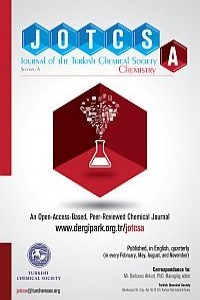UZAMA FAKTÖRÜ – TU’DA (EF-TU) GTP HİDROLİZ MEKANİZMASI
Uzama Faktörü Tu (EF-Tu) bir G proteindir ve GTP ile üçlü kompleksi halinde doğru amino asidin ribozoma tasınmasında görev alır. Diğer G proteinlerinde olduğu gibi EF-Tu proteinin fonksiyonu GTP veya GDP bağlı olup olmamasına göre değisir. EF-Tu sadece GTP ile kompleks olusturduğunda aminoasil-tRNA’ya bağlanabilir. Doğru kodon ve antikodon eslesmesi sağlandığında GTP hidrolizi gerçeklesir ve EF-Tu ribozomdan ayrılarak aminoasil-tRNA’yı ribozomun A bölgesinde bırakır. GTP hidrolizi proteinin aktivitesi için en kritik adımdır [1, 2].Bu çalısmada GTP hidrolizinde görev alan kalıntıları teaspit etmek için, QM/MM metotları kullanıldı. Genel olarak Histidin 85 (His85) ve Arjinin 57 (Arg57) (T. aquaticus numaralandırması) kalıntılarının rolleri üzerine odaklanıldı. Bu kalıntılar kosullara bağlı olarak aktif bölgenin dısında veya içinde konumlanabilir. His85’in aktif bölgede konumlandırıldığı, Arg57’nin aktif bölgedeolduğu ve her iki kalıntının da aktif bölgenin dısında olduğu farklı modeller incelendi. Sonuçlarımız Arg57 ve His85’in aktif bölgede yer alması durumunda aktivasyon enerjisinin azaldığını ve bu kalıntıların katalitik rol üstlendiğini gösterdi.Diğer önemli bir konuda da hidroliz reaksiyonunun asosyatif veya disosyatif yoldan gerçeklesip gerçeklesmediğidir [3]. GTP hidrolizini temsil eden farklı asosyatif ve disosyatif model yapılar optimize edildi ve enerji değerleri karsılastırıldı. Tüm optimize edilen geçis yapıları asosyatif karakter gösterdi. Çalısılan modellerde disosyatif mekanizmaya ait durağan noktalar elde edilemedi. Disosyatif mekanizmanın gerçeklesmesinin olası olduğu noktalarda enerjinin arttığını gözlemlendi.
Anahtar Kelimeler:
-
THE GTP HYDROLYSIS MECHANISM IN ELONGATION FACTOR –TU (EFTU)
Elongation factor Tu (EF-Tu) is a member of G protein family, and as part of a ternary complex with GTP, plays a critical function in translation by delivering aminoacyl-tRNA to the ribosome. Like other G proteins, the function of EF-Tu depends on whether GTP or GDP is bound. When EFTu is complexed with GTP, it can bind the aminoacyl-tRNA. Upon cognate codon-anticodon pairing, GTP is hydrolyzed and EF-Tu is separated from the ribosome leaving the aminoacyl-tRNA at the A-site. Hence, GTP hydrolysis is the critical step for the activity of the protein [1, 2]. To identify the residues involved in GTP hydrolysis mechanism of EF-Tu, we have used QM/MM methods. In particular, we have focused on the roles of Histidine 85 (His85) and Arginine 57 (Arg57) (T. aquaticus numbering). These residues can be situated inside or outside of the active site depending on the conditions. Therefore we have studied three different models: one with His85 in the active, one with Arg57 in the active site and one where both His85 and Arg57 are outside of the active site. Our results indicate that the presence of Arg57 or His85 in the active site decreases the activation energy, indicating that these residues have catalytic roles. Another important issue is to determine whether the hydrolysis reaction proceeds via anassociative or dissociative path [3]. To this end, different model structures representing the associative or dissociative path of GTP hydrolysis have been optimised and the energy values have been compared in order to identify the mechanism. All optimised transition structures have associative character. Stationary points involved in a dissociative mechanism could not be located, suggesting that such a mechanism is unlikely, at least for the models studied. We observe that the energy increases at the points where the dissociative path is supposed to occur.
Keywords:
-,
___
- I.M. Krab, A. Parmeggiani, Biochim Biophys Acta., (1998).
- R.M. Voorhees,T. M. Schmeing, A.C. Kelley, V. Ramakrishnan, Science, (2010).
- S.C. Kamerlin, P.K. Sharma, R.B. Prasad, A .Warshel, Quarterly reviews of biophysics, (2013).
- Başlangıç: 2014
- Yayıncı: Türkiye Kimya Derneği
Sayıdaki Diğer Makaleler
Niyazi Bulut, Jacek Klos, Octavio Roncero
AMOKSİSİLİNİN FOTOKATALİTİK DEGRADASYONU: HESAPSAL OLARAK REAKSİYON YOLLARININ BELİRLENMES
CavAb KANALINA KALSIYUM VE SODYUM İYONUNUN BAĞLANMA MEKANİZMASI
Turgut Baştuğ, Murat Çavuş, Serdar Kuyucak
YENİ BİR POLİMER ÜZERİNDE TEHLİKELİ ORGANİK ÇÖZELTİLERİN ADSORPSİYON DAVRANIŞI
Gizem Akdut, Fatih Bildik, Filiz Şenkal, Tuba Şişmanoğlu
Ca3Co4O9 SĐSTEMİNİN ELEKTRONİK KONFİGÜRASYONU İÇİN SİMETRİ FAKTÖRÜ
UZAMA FAKTÖRÜ – TU’DA (EF-TU) GTP HİDROLİZ MEKANİZMASI
Ayla BAŞARAN KINALI, Bülent BALTA, Neş'e BİLGİN, Viktorya AVİYENTE
F. SUNGUR KONUKLAR, M. DEMİRKIZAK
FENİLALANİN’İN GEÇİŞ METAL İYONLARI TARAFINDAN OKSİDATİF BOZUNMASININ İNCELENMESİ
